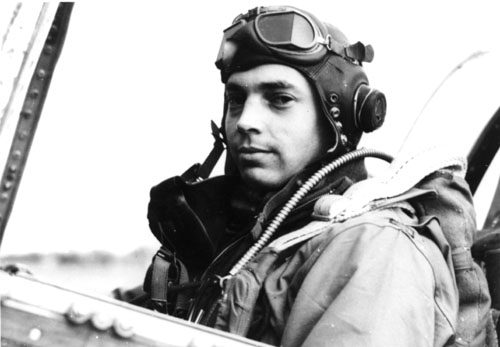
Captain William B. “Bill” Overstreet, 363rd FS
Training; Hamilton Field; Assigned to 357th FG
I was born in Clifton Forge, Virginia, on April 10, 1921. On December 7, 1941, I was working as a statistical engineer for Columbia Engineering and attending Morris Harvey College. I wanted to get in the Air Corps as a fighter pilot, so I did a lot of talking just to be accepted. By February 1942, I was a Private, waiting for an opening as an Aviation Cadet. After several months, I was sent to Santa Anna, California, for preflight. After several months at preflight, I was sent to Rankin Aeronautical Academy in Tulare, California, for primary flight training flying Stearmans.
The head of the school, Tex Rankin, was a champion aerobatic pilot and demonstrated his skill. My instructor, Carl Aarslef, was great. He had unusual methods of testing his students. One thing he surprised me with – on the downwind leg of the landing pattern, at 500 feet, he would turn the Stearman upside down, cut the engine off, and say, “OK, you land it.” Of course, that was easy, just quarter roll it into a left turn, line up with the runway and set it down. I guess the real test was for your reaction. Another maneuver was to pull it up into a normal stall, walk the nose down and through vertical, then push the nose up inverted into an inverted stall, repeating until the ground got close.
Then, I was on to basic at Lemoore, California. This was in the Vultee “Vibrator” with an adjustable prop pitch. We could dive down to buzz someone or something and set the prop to really roar over our target. My next stop was advanced at Luke Field, Arizona. The commanding officer indicated I should go to Williams Field for multi-engine advanced training, but I was able to convince the Captain that I had to be a fighter pilot. Anyway, the AT-6 was really fun to fly and I got to check out in the P-40 before we got our wings.
Upon graduation, a group of us was assigned to Hamilton Field, California. Then we went on to the 357th Fighter Group, 363rd Fighter Squadron. They were moving from Nevada to Santa Rosa, California. We got to fly with experienced pilots and learned a lot. Flying at Santa Rosa was great. There was enough moisture in the air to leave streamers from the wing tips in a tight turn. Our goal was to get a flight of four, come to the end of the runway, peel up in a tight turn and land before the first plane’s streamers had faded. I flew with several flight leaders, but mostly with Lloyd Hubbard. He was good. We all thought we could buzz pretty closely, but while we may be able to “mow the fairway” on a golf course, only Hubbard could “mow the greens.”
“Hub” also liked to take a flight of four to the Golden Gate Bridge and do loops around it. You know we were having fun! Complaints came in and charges were placed. Jack Meyers, our legal officer, told me years later that he was able to hold up action on bushels of charges, and took most home with him after the war. We liked to buzz farmers, sunbathers or anything. Years later, I asked Don Graham why we got by with so much. He replied, “If you were picking pilots for combat, who would you pick? The fellows who flew straight and level or the ones who pushed the envelope and tested the limits of their planes?”
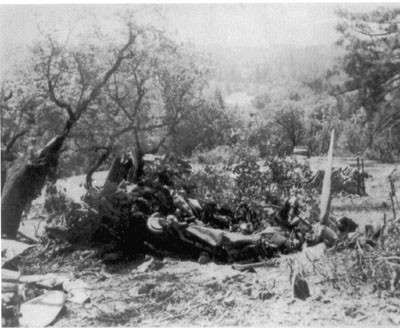
What a P-39 looks like when it “Tumbles In”. This was Bill’s shortest parachute jump. “When the chute filled with air and stopped my fall, my feet hit the ground beside the prop.” The other members of the flight never saw Bill’s chute.
We were losing too many pilots and planes from the P-39 tumbling and going into flat spins. It happened to me in combat training on June 28, 1943. We had been practicing aerobatics when my plane started tumbling and I couldn’t control it. When I released the doors, they wouldn’t come off. Pressure had built up against them. I finally got my knee against one door and my shoulder against the other to overcome the pressure. When I got out, I pulled the ripcord immediately. When the chute opened with a jerk, I was standing by the prop among cannon shells. I still have the ripcord, and visited Hamilton Field to thank the parachute packer. I believe I was the first to get out of a tumbling P-39.
Another day, four of us were practicing aerobatics and had reformed in formation to return to base. We saw a P-39 diving on us, so we broke as if to start combat. The P-39 started to snap roll right through where we had been. Later, Ellis Rogers, a nice fellow but a big man, came over saying how sorry he was – he had intended to join us but his P-39 had other ideas. Rogers was so big and the P-39 so small that he had to lift his legs to move the stick from side to side. He must have wished for a much larger plane.
My father brought my 1938 Buick to California for me. I was able to take him for a ride in our AT-6. That was a thrill for both of us. With the car, we were able to visit places like Russian River, Bucks Lake and other points of interest.
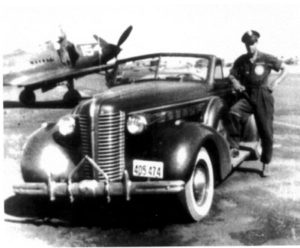
Bill Overstreet and his favorite auto and plane at the time!
Soon the Squadron moved to Oroville, California. We were still gaining experience flying the P-39, and learning all the time. One mistake we made was to have four of us meet over the field from North, South, East and West. Then, we would split S to the field, cross below the tower, pull up and reform. We got a radio message, “The visiting General wants the four P-39s who buzzed the tower to land Immediately.” We obeyed, but chose another base to land on. We didn’t feel welcome on our home base at that time. More paper work.
Our next move was to Casper, Wyoming. I got a short leave to take my car home. I took Dave Kramer to Missouri and “Muscles” Molday to Ohio on the way. Then, I hitched a ride in a B-24 from Washington, D.C. to Wyoming. I remember getting a free meal at the Hotel in Casper because one of our pilots had killed an antelope and donated the meat to the Hotel during meat rationing. Another time, I rode with Don Graham to pick up pilots from local night spots and bring the back to the Base. I didn’t know it was possible to get that many bodies in a Lincoln coupe. And, I will never tell where we found some of those fellows!
We were declared combat ready and shipped to Camp Shanks, New Jersey, for shipment overseas. Although we were supposed to be confined to the Base, we got to a night club in New York City. I have a great picture of a bunch of us at that club. Soon, we were loaded onto the Queen Elizabeth to cross the Atlantic. I remember Bill “O’Bee” O’Brien kicking his B-4 bag up the gangplank. He had suffered a .45 wound in the arm in an accident. He told me later that the RAF decided to ground him and ship him back to the States. “Doc” Barker, our Flight Surgeon, overruled them when O’Bee promised he would be able to fly.
Leiston, England
We landed in Scotland and went on to Raydon in the Ninth Air Force. We arrived to a sea of mud and no planes. By then, P-51s were becoming available and the Eighth Air Force wanted them for long-range escort. So, we were traded to the Eighth for a P-47 outfit at Leiston. While in Raydon in all that mud, we were required to dress for dinner. War is hell.
After moving to Leiston, there was more paving and less mud. We started getting P-51s. What a Great Day! I got to fly a p-51 for the first time on January 30, 1944. As the inventory of planes increased, it seemed they hoped for us to get at least 10 hours in the new plane before combat. On February 8, Lloyd Hubbard flew with another Group to get some combat time. Unfortunately, while strafing a German airfield, he was hit and killed. That left Peters, Pascoe and me to be shifted to other flight leaders. I flew with several until I flew as “Tail End Charlie’ with Anderson. From then on, I tried to fly with him whenever possible. I thought then (and still do) that he was the greatest. His record sure proves it.
I named my first plane, “Southern Belle.” However, a few weeks later when another pilot was flying it, they failed to return. By then, early March, we had started going to Berlin on a regular basis, so I named the rest of my planes, “Berlin Express.”
On March 6, just after the first Berlin raid, the 357th showed what our training and teamwork could do. Our combat training and the entire group working together produced tremendous results. Here is a quote from our first Citation:
“On 6 March, 1944, the newly operational 357th Fighter Group provided target and withdrawal support to heavy bombardment aircraft bombing Berlin, which was the deepest penetration of single-engine fighters to that date. The 33 P-51 aircraft went directly to Berlin and picked up the first formations of B-17s just before their arrival over the city. They found the bombers being viciously attacked by one of the largest concentrations of twin-engine and single-engine fighters in the history of aerial warfare. From 100 to 150 single-engine and twin-engine fighters, some firing rockets, were operating in the immediate target area in groups of 30 to 40 as well as singly. Each combat wing of bombers was being hit as it arrived over Berlin and although they were sometimes outnumbered as much as 6 to 1, flights and sections of the 357th Group went to aid each combat wing as it arrived over the target, providing support in the air for over 30 minutes. Upwards of 30 enemy aircraft at a time were attacked by these separate flights and sections, and driven away from above and below the bombers. Some of the P-51s left their formations to engage enemy fighters below the bomber level in order to prevent them from reforming for further attacks. Though fighting under the most difficult conditions and subjected to constant anti-aircraft and enemy aircraft fire, so skillfully and aggressively were their attacks on the enemy fighters carried out that not a single aircraft of the 357th Group was lost. In driving enemy fighters away from the bombers, 20 Nazi fighters were destroyed, one probably destroyed and seven others damaged. On withdrawal, one flight of five P-51s strafed a large enemy airfield in central Germany, damaging three twin-engine and single-engine aircraft on the ground and killing 15-20 armed personnel before regaining altitude and returning to the bombers.”
Not long after this, I had a freak accident. I think it was a mission to southern France. While over enemy territory, a burst of flak cut my oxygenline. Since I was at about 25,000 feet, I soon passed out. The next thing I knew, I was in a spin, engine dead since the fuel tank it was set on was dry. Somehow, I recovered from the spin, changed fuel setting, got the engine started, and dodged the trees that were in front of me. Then, I looked at my watch. Ninety minutes were not in my memory. I had no idea where I was, but remembered where I had been headed so I reversed it. I was able to find the coast of France and headed for Leiston. By this time, I was low on fuel, so I landed at the Fourth Group base. The officer I talked with was Captain Mead, who had lived a couple of blocks from my home in Clifton Forge, Virginia. To top it off, the mechanic who repaired my plane was “Hot Cha” Tucker, a former schoolmate, also from Clifton Forge. I still have a picture of Tucker and me with a P-47. Many weeks later, this story got a lot of publicity – Lowell Thomas on radio, newspapers and TIME magazine. So, that is my claim to fame. I hope I did a little bit that was productive.
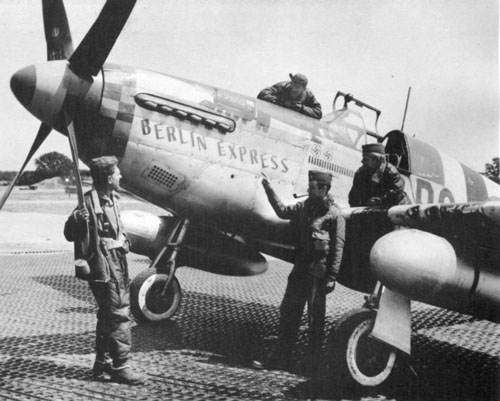
Lt William Overstreet points to the name of his P-51C-3-NT, 42-103309, in June 1944.
During this period, I was flying more with Andy Anderson, while Peters and Pascoe were flying more with Jim Browning. My crew chief was “Red” Dodsworth with “Whitey” McKain as his assistant. Whitey was soon promoted. Whitey and I became good friends in spite of one incident. One snowy day, the visibility was so limited that Whitey was riding my wing to the runway. At the runway, I motioned Whitey to get off, but he thought I wanted him to come to the cockpit. I was watching Andy and he gave it the gun to take off, so I did the same. Poor Whitey was blown off the wing, but was wrapped up so well he wasn’t hurt. I was very glad of that. I never knew of this until, many years later. Whitey was riding with me and told me he had promised himself never to ride with me again. He did ride with me to Oshkosh several times and we had a ball.
Another mission that didn’t turn out as expected was one when I had a sinus infection. When we chased the German fighters out of position to attack the bombers, if most of them had dived away from us, we would sometimes chase them down. This time, I was chasing a 109 in a power dive from about 30,000 feet. Suddenly, my eyes were swollen shut. I was able to keep flying by feel (the pressure on the controls). I called for help and “Daddy Rabbit” Peters said he could see me. He got on my wing, took me back to the base and talked me through a straight-in approach and landing. It was days before doctors could relieve the pressure, and I could see again.
On April 11, 1944, I was flying with Andy, Kayser and Simpson. While we were escorting the bombers, a large group of 109s started to attack the bombers head-on. Andy led us into the fight, trying to break up their formation and keep them from getting to the bombers. Maybe they didn’t like being shot at, but they scattered all over. When most of them had dived away, Andy led us down after three 109s. At about 5,000 feet, Kayser got in position and clobbered one of them. It broke apart and Kay had to dodge the debris. At about 3,500 feet, Simpson closed on another 109 and got two good bursts to the nose section. He rolled over and went straight in. I was busy with another 109 who tried to get behind Simpson. Andy was turning with another 109 in a tight turn. Andy couldn’t hold a lead inside his turn, so he reversed his turn and came in almost head-on. As the 109 broke apart, the pilot bailed out. That took care of the 109s, but Andy spotted a HE111K flying close to the ground. Andy hit him good but directed all of us to make a pass. We all got hits and Andy came back, hitting it from nose to tail. The HE111K tried to crash-land, hit a pole tearing off the left wing, then started burning. As it slid along, the crew jumped out and I believe they were all track stars. They were in a hurry. Andy insisted on sharing the claim, although he easily could have claimed it. He would rather give us some experience and training.
During May, 1944, Colonel Graham ordered side arms to be carried at all times. There was an alert about German paratroopers. On May 12, I destroyed a JU52 on the ground. Andy got another 109 in the air. With Pierce and Michaely, we also destroyed a locomotive, rail cars and some barges.
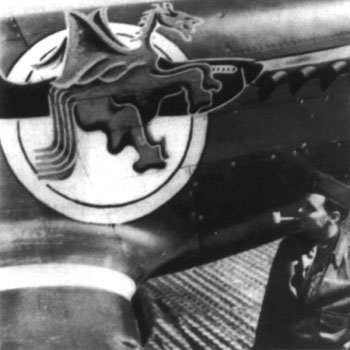
Bill with his “Berlin Express” with artwork Winged Mustang on the right side.
D-Day through October, 31, 1944
June 6 was the invasion. We took off about 2 a.m. in horrible weather. We had to climb about 20,000 feet to get out of the overcast. It was beautiful when I got on top. The moon was bright, and as planes would break out of the overcast, they were in different attitudes from the long climb on instruments. We never did find our assigned flights, just formed up in flights of four. We went to France to make sure that no German fighters could bother the invasion, and to prevent reinforcements from being brought up. After six hours, we came back to the base for fuel. The Group flew eight missions on the day of the invasion. Smaller flights had different objectives.
The next day, Andy, Simpson, Skara and I strafed trains, trucks and military vehicles. On June 10, the Group claimed trains, rail shacks, boxcars, trucks, lorries and barges. June 29 was a good day. I got behind a FW190 and when I started getting hits, he flipped over and bailed out. I used only 40 rounds the whole day. General Kepner issued another commendation for the 357th and the 361st Groups. We destroyed 48 enemy aircraft without losing a single bomber.
On July 29, I chased a 109 to the deck and had a wing in the grass when he blew up. He must have been trying to get to his base because we were close to a German airfield. My wingman, Harold Hand, and I made a pass and destroyed another 109 and damaged a DO217. I went back and got another 109 but I found that I was alone. I asked Hand where he was and he replied, “I am giving you top cover.” Smart fellow.
On August 6, we started on our shuttle mission. I was leading a flight with Cleland, Pearson and Fennel. Jack Cleland was a New Zealand RAF pilot who had flown two tours in Spitfires and came to us to get some experience in longer missions. On his two tours in Spitfires, no mission had exceeded two hours. What a mixed flight – Cleland and Pearson. Pearson was an American who had gone to Canada, joined the RCAF, then transferred to the USAAF and the 357th. About 7 hours later and after several dogfights on the way, we landed on a grass field in Russia.
The 357th had sent some mechanics as gunners on the bombers so they could service our planes. The trouble was, the bombers landed at a different field and the mechanics never got to our P-51s. The Russian crews put the wrong octane fuel in some of our P-51s and caused a lot of trouble. I was assigned a cot in a tent that came complete with a blacksnake in the cot. When I saw a P-39 on the field, I asked if I could fly it since I had a lot of time in P-39s. Not a chance. They wouldn’t let me get within a hundred feet of it.
We had one escort mission out of Russia. This gave enough time in Russia to find some beet vodka. We thought it was better than potato vodka and decided we should take some along with us. I offered to leave my ammunition behind to make space for the vodka. That was fine until we ran into some 109s on our way to Italy. Naturally, we went after them, but they ran away. However, we got close to the last one and he rolled over and bailed out. Since I was the closest plane, I could have claimed another 109, but I did not want to claim the only enemy plane destroyed with vodka! Now all I had to worry about was to make a smooth landing in Italy to safeguard my precious cargo. Our mission from Italy was a real thrill. We escorted C-47s to Yugoslavia to pick up downed airmen collected by Tito and brought to a small airfield. The C-47s took turns landing and picking up a load of men, then taking off. The amazing sight was as the fellows jumped into the C-47, they were throwing out their shoes, clothing, etc., for their rescuers. I guess everything was in short supply, and our airmen wanted to help those who had helped them. All that was left of the shuttle mission was the return to England. That took about 8 hours. How do you think Cleland, whose earlier missions had not exceeded two hours, felt by then?
I remember many exciting missions. On one, a 109 blew up when I was too close. Pieces of the 109 came into my cockpit and landed in my lap. I still have that piece of extremely light and strong metal. On another, I saw a 109, in a shallow dive after the pilot bailed out, crashing into the side of a factory. Then the engine itself came out the other side of the building, sliding down the street. On still another mission, a cannon shell came through the side of my canopy. It took the canopy, oxygen mask helmet, gave me a haircut, and a bad burn on my neck. Everyone knows you can’t hit a 90-degree shot very often, so I still wonder who the German was shooting at. At least I knew why my canopy was missing. Kit Carson lost his canopy on a mission and was angry with his crew chief until the crew chief took him over to the plane and showed him the bullet holes that caused the canopy to leave. Kit didn’t know until then that he had been hit.
On September 3, 1944, Ed Hiro and I went to a base where they had a B-24 stripped down but loaded with explosives. A pilot had to take off, then bail out when the radio control from the “Mother Ship” took over. By radio control, the bomber was flown in the sub pens and blown up. The sub pens were under heavy rock formations that had resisted bombing from the air. But when the explosion was inside, under the rock cover, significant damage was achieved. Our job was to make sure no enemy planes bothered the mission. My mission log for this day is marked “SECRET.”
This is when the OSS asked me to fly for them. They were already operating almost a regular airline to the Free French behind enemy lines. We picked up airmen downed behind enemy lines, collected intelligence, and provided supplies to the Free French. Soon I was grounded again, and ordered back to the States. What a Halloween present for my family!
I have only described some of my experiences, and have many more to tell.
Bill Overstreet
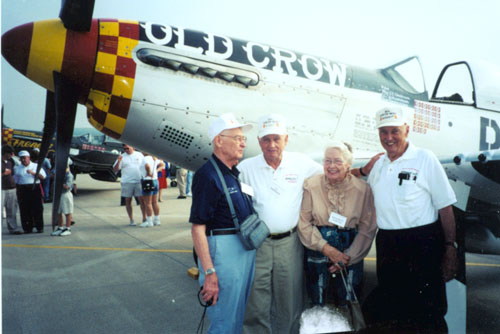
Merle Olmsted, Bud Anderson, Margreth Olmsted and Bill, at the last 357th FG Association Reunion, Sept 2001
Short Snorter from Bill Overstreet
A “short snorter” was carried by pilots of the 357th FG. Bill says the US dollar was required during initial training with the 357th and if you did not have it with you in the bar, you brought a round for all present. The English currency was added at Leiston. The Russian currency was added after Bill’s Shuttle mission to Russia. Some of the names on the bills are Chuck Yeager, OBee O’Brien, Tiede, “Daddy Rabbit” Peters and other 363rd FS pilots.
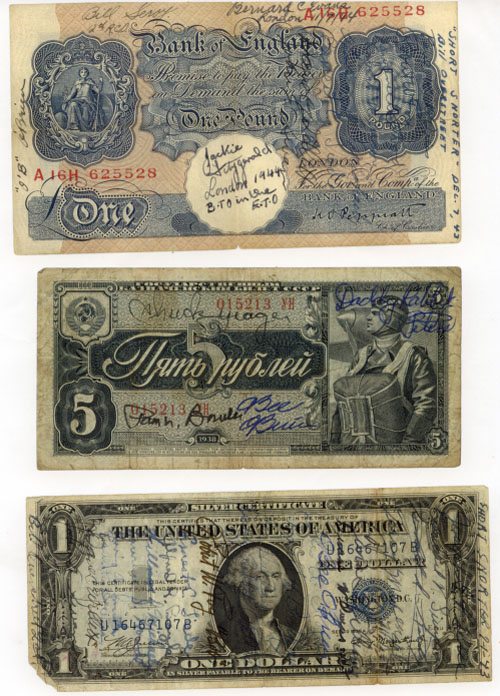
On 6 August, 1944, the 357th Fighter Group was selected to escort B-17s from the 8th Air Force’s 3rd Bomb Division on a shuttle mission to the Soviet Union. Seventy-two of the group’s Mustangs took off from Leiston and sixty-six rendezvoused with the bombers seventy-five miles northwest of Gydnia, Poland. the group engaged several Me 109s near Gydnia, shooting down two of the German fighters. They regrouped after driving off the rest of the Me 109s and continued to escort the bombers until reaching Kiev. Seven and a half hours after taking off from Leiston, all of the 357th’s P-51s landed at Piryatin.
The group escorted B-17s to Cracow, Poland, on the 7th and to Foggia, Italy, on the 8th. Lieutenant Bill Overstreet realized these mission were unique and began to feel sorry for the members of the group who were left behind in Leiston. He did not expect resistance from the Luftwaffe on the group’s mission to Foggia. As a result, he traded the .50 caliber ammunition in his Mustang for bottles of vodka and loaded them in the now empty ammunition bays. The flight was uneventful until the group spotted Messerschmitt 109s over Romania. The Germans spotted the 357th almost as quickly and ran for home at full throttle. As the group chased the German fighters, Overstreet managed to get on the tail of a Me 109 and saw, to his amazement, the German pilot bail out of his fighter, even though he had not been hit. Regarding this incident, Overstreet wrote:
No one fired at the one who bailed out, so imagine the smiles on the faces of the fellows when we were asked at the debriefing, “Who was the closest one to him?” I was the closest, but I had vodka, not bullets. That (Me 109) could have been awarded to me as an aerial victory, it wasn’t.
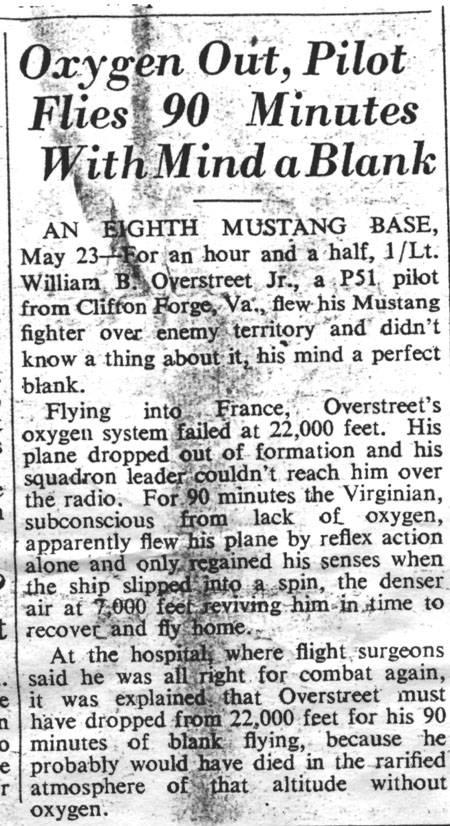
Stars and Stripes Article from May 24, 1944. Donated by John Cirillo.

